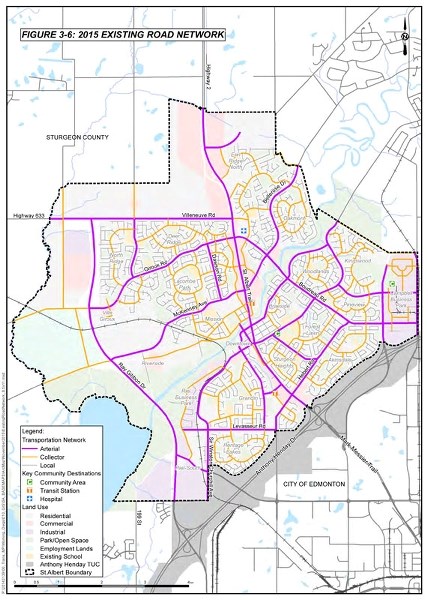Improving and encouraging the use of more active forms of transportation is a big part of the new version of the city’s transportation master plan.
The draft plan was unveiled at Monday’s council meeting.
“It’s quite the document,” said Coun. Wes Brodhead. The plan and its appendices weigh in at more than 400 pages. Council has a few weeks to give its comments and the plan will be considered for approval at a later date.
Council members asked questions on Monday, ranging from concerns about the population projections being too large to how to encourage people to get out of their cars.
“People love their cars and it’s hard to change that,” said Coun. Tim Osborne.
The plan itself has a lengthy action item list for implementation. Topic areas include the roads and drivers, public transportation, commercial/goods movement through the city and active transportation, such as walking and cycling.
A great deal of the traffic on the main roads of St. Albert is just passing through, the intercept study showed. The plan says increasing capacity on Ray Gibbon Drive and other regional projects, like 127 Street, would help alleviate the stress on St. Albert Trail.
The plan offers strategies and long-term suggestions for the roads like the development of future truck route networks, anticipates the planned St. Albert LRT line, considers public transportation – both transit and ride sharing – offers suggestions for increasing active transportation – like bike lanes or multi-use trails – and talks about using emerging technologies to help improve road management and capacity in a more responsive way.
Kent Eklund from Associated Engineering, a firm which worked on the plan and the public engagement, told council that the household travel survey revealed a large portion of automobile trips in St. Albert – 27 per cent – are less than five minutes in duration.
“If we could change 30 per cent of that to where they actually ride their bike or walk,” Eklund said, it could help reduce traffic.
The report notes much of the road network in St. Albert is already built out. That means the goal of the transportation master plan, said city transportation manager Dean Schick, is to increase efficiencies for all road users.
In an interview, Schick said the inclusion of plans to encourage more active transportation, including by building facilities to make cycling, walking or other modes easier, doesn’t mean the vehicular experience will be sacrificed.
“The key is not that you … [are] accommodating one mode for another, but you make sure that all modes are, again, accessible, accommodating and efficient or as efficient as possible,” he said. “We had concerns that when you put focus or emphasis on active or alternative modes, there’s a shift where you’re essentially lessening the effectiveness of typical passenger vehicle travel, and that’s not the case.”
While council has until Feb. 19 to share its comments, some had thoughts ready to share at the meeting.
Coun. Cathy Heron suggested that more be incorporated about autonomous vehicles, but said overall she liked the plan and was happy it highlighted the built-out nature of St. Albert’s roads.
“To me it’s quite obvious the more cars we get off the street the less congestion there will be for those that remain,” she said.
Coun. Sheena Hughes said the report shows the importance of twinnng Ray Gibbon Drive, something she said can’t be underestimated.
She also noted that winter months might mean that those who chose walking or cycling in the summer will be in cars when the snow flies.
“We have to face that reality … those cars are going to be used for a minimum of six months,” she said.
Mayor Nolan Crouse said traffic appears to be an important concern in nearly any region, but praised the “good work” being done by Schick and the others.




